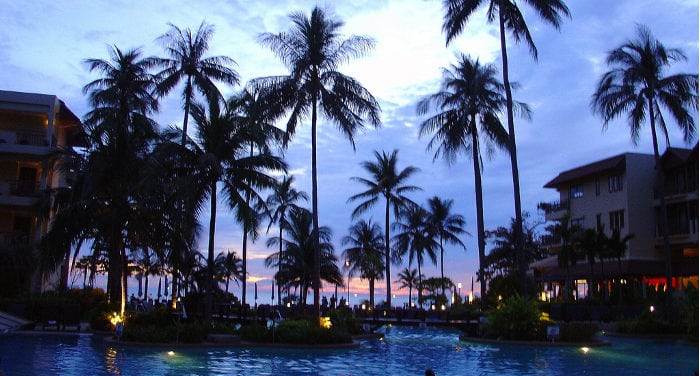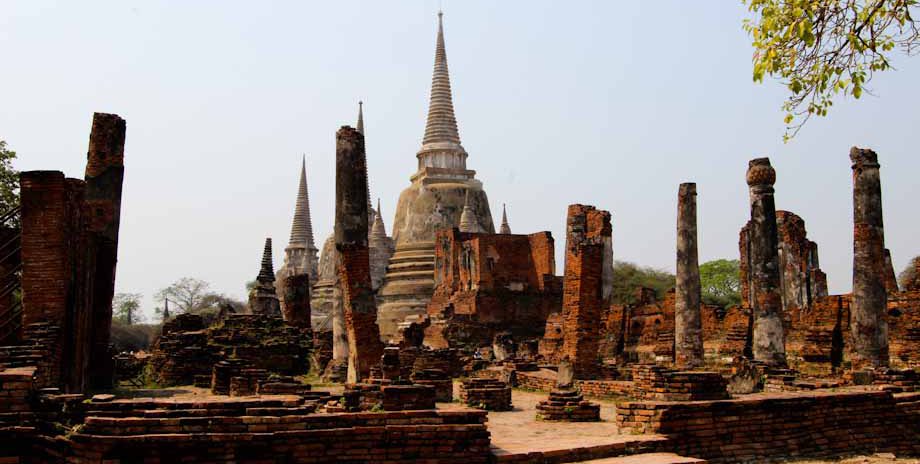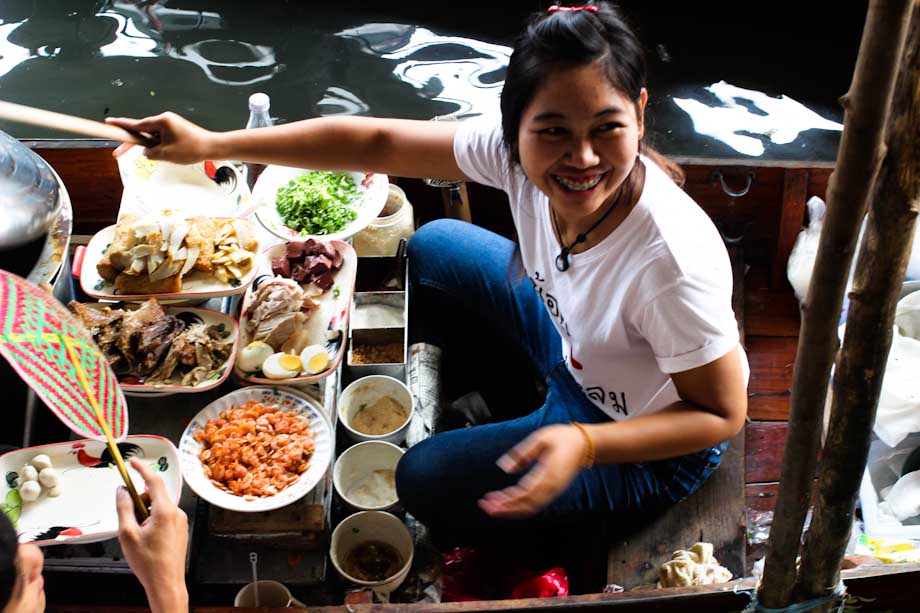
Despite having its prefix Koh removed (in Thai: island), Phuket is Thailand’s biggest island, connected to the mainland (Phang Nga province) thanks to a 700 meter long bridge. Before the construction of the Sarasin Bridge,the only way (besides by air!) to reach the mainland, was the ferry.
After the construction of the Sarasin Bridge in 1967, the Thai tourism authority in 2011 was forced to build a second bridge, the Thepkasattri Bridge, due to the imposing increase of vehicles headed toward the island. Today the Sarasin bridge is resigned to a simplistic touristic role; platforms were built to allow tourists to photograph the sunrise or sunset looking directly over the Andaman Sea.
With its 570 square kilometers, and almost four hundred thousand inhabitants, the island of Phuket attracts more than 11 million tourists a year, thanks to its renovated international airport.
The island is predominantly mountainous, with its highest peak (Mai Thao Sip Song) reaching 529 meters above sea level. Excluding the 70% of territory covered by mountains, the remaining 30% is covered by rice paddies, bamboo and coconut plantations, and the park Khao Phra Thaeo.
This forest is the only remaining protected area on the island, with a surface area of 22 square kilometers composed of three hills with a maximum height of 422 meters.
General information
During the last twenty years, Phuket, and Thailand in general, have seen an ever-increasing influx of tourists. Unlike the 90’s, when Phuket’s beaches were uncontaminated and paradisaical, today anyone expecting to find Phuket a tropical paradise is very mistaken!
Because of mass tourism, the island’s hotel association has made a specific request to the Thai ministry of tourism: place a maximum number of tourists that can visit per year. The minister of sport and tourism has responded positively to this proposal, underscoring that in this way they could also eliminate various hotels and illegal tour operators, which make their money by offering low cost services for groups of tourists who want to keep the cost of their vacations down.
Despite the presence of seven thousand hotels on the island, of which 60% are illegal, for now the Thai government has not yet managed to formulate a project for stopping this ever-growing phenomenon.
Phuket’s climate is similar to the rest of Thailand, even if there might be a few variations regarding the high probability of rain even during the dry season. When you get to Phuket you’ll immediately notice that its a very green island, unlike other Thai islands where the weather is drier, such as Koh Samet.
Despite the rainy season which goes to from April to October, it is possible to visit Phuket and run into constant and uninterrupted rain, such as occurred in January of this year. Generally however, the best time to visit the island is from November through March.
The island of Phuket is characterized by the many ethnic groups present; it is in fact the only Thai territory where a European nation succeeded in inculcating a good part of its traditions: Portugal. Thanks to its strategic location between China and India, Phuket (as part of the Kingdom of Siam) became a meeting point among the various naval powers of the XVI century.
Obviously the Phuket of today is far less European; being characterized by many ethic Chinese, Thais, and even Malaysians. In the Phuket region near Kamala Beach, it is possible to note a higher concentration of the Muslim Thai population.
Phuket has also become quite famous thanks to various American films set on nearby islands, two of which are “The Beach” with Leonardo di Caprio, filmed both in Phuket Town (the island’s capital), and Phi Phi Island in 2000. The second film is “The Man with the Golden Gun – James Bond” with Roger Moore, filmed on Tapù Island in 1974. This small island is even today the destination for many tours organized by practically every tourist agency on Phuket.
How to get to Phuket
By air
The most comfortable way of getting to Phuket is definitely by air. Whether from Bangkok or Europe, there are ample and convenient flights to Phuket offered by airlines.
Frights from Bangkok to Phuket and vice versa number more than fifteen each day. There are various airlines offering this route: Air Asia, Nok Air, Lion Air, Bangkok Airways, Thai Airways.
The first three companies are considered low cost, in fact the price of tickets for a round trip Bangkok – Phuket flight, hover around 2,000 THB, depending on the season. Tickets with the two national carriers instead start at 5,000 THB a person (again round trip).
Besides Bangkok, you can get to the Phuket international airport from Chiang Mai, Pattaya, Udon Thani (the flight lasts about an hour and half), but also from international destinations like Australia, Cambodia, China, Brunei, Hong Kong, India, Japan, and many other destinations, including Hawaii.
Regarding European routes, there are no direct flights to Phuket; There are however flights with just one stop that leave from many European cities like Milan, Berlin and Zurich. They don’t always stop in Bangkok, often the last leg to Phuket will leave from Singapore or Hong Kong.
Once you land in Phuket you have three ways of reaching your destination:
- Take a taxi. This is the most popular option if you’re staying in a smaller resort along the beach or less serviced by public transportation (which is almost nonexistent on the island!). In this case the cost ranges from 500 to 800 THB per car. If you decide on this option I recommend that you negotiate the price with the driver in advance, so as not to find yourself in an unpleasant situation, since taxi drivers on Phuket are known for not using their meters.
- Take a public bus, which connects the airport with the city of Phuket Town. A ticket costs 100 THB a person, and you can take the bus directly from the airport. When you exit the terminal you’ll find a bus stop on the left with timetables. This option is very convenient but pointless if you’re staying in Patong or one of the other beaches, since it goes directly to Phuket Town, stopping only in the interior. It takes up to three hours to get there during peak hours such as the morning or in the evening from 17 on.
- For those heading to Patong, near the public bus line stop, there are buses and minivans that bring tourists directly to Patong Beach. The big bus is free, while minivans costs between 300 and 500 THB a person, depending on the company.
If it’s more important that you save money instead of time there’s a fourth option you can take: catch a bus to Phuket Town and from the center of town (the market), you can take another bus to Patong for the modest sum of 30 THB, thereby saving 200-300 THB.
By bus
A valid alternative for getting to Phuket is to take a long distance bus. The main terminal for buses heading to Phuket is found in Bangkok, more specifically in the southern station. The first buses leave at 6:30 in the morning, and the last leave at 8:30 at night. There are no departures from 7 in the morning to 3 in the afternoon.
The trip takes about 13 hours and costs about 630 THB (one way). If this option works for you, you can buy tickets directly online at 12go.asia, or the official site of Thai railways.
Comparing the price of a bus ticket and air ticket, especially in the low season, you’ll note that the difference in price isn’t much different; in fact, at times the air tickets (especially on Air Asia) cost less!
Click here to read our guide on buses in Thailand.
By train
Getting around by train in Southeast Asia is an experience that every traveler should have. In Thailand rail service is well-organized, so is buying tickets and timetables.
Bangkok’s railway station (Hua Lamphong), is found in the neighborhood near China Town. To get to Hua Lamphong you can take the BTS to Asoke station, and then take the metro to Hua Lamphong, which is the last station on the blue line (the city’s only metro line).
Upon arrival at the station, you can buy tickets directly from the counter, even for successive days and weeks without a transaction cost. Some internet sites offer train ticket sales with drop-off at your hotel or apartment in Bangkok, with an administrative cost of 200 THB.
Unfortunately there’s not direct connection between Bangkok and Phuket. The only possible itinerary is to depart from Bangkok and go down to Surat Thani, then take a bus that will bring you to Phuket in about five hours.
The problem is that there aren’t any direct trains for Surat Thani station, considered the transport epicenter of the southern part of the country. The only way to get there is to stop in Chumphon.
Many agencies offer this package for a cost of 1,700 THB for night trains with bunks, and 1,200 THB for second class on day trains.
With this choice the time it takes and the cost of the ticket make the trip less appealing. In my opinion, if you’d like to experience riding a train in Thailand, the best itinerary is Bangkok – Chiang Mai, with a night train or one that leaves early in the morning so as to fully enjoy the amazing landscape immersed in green.
Click here to read our guide on traveling around Thailand by train
Where to stay
For more information on where to stay in Phuket, click here to read our guide on hotels in Phuket.
The cities: Phuket Town and Patong
The island of Phuket is divided into three districts: Amphoemueang Phuket, Amphoe Khatu, and Amphoe Thalang. There are two main cities on the island: Phuket Town, the capital, and Patong, <a href="https://www.saporedicina.com/viaggio-a-pattaya/" target="_blank"the Pattaya of the south.
Phuket Town
Phuket Town is part of district 1 (Amphoemueang Phuket), or the southern part of the island. The city is unique in Thailand in that it has a Portuguese influence; you can see it in the colonial style of the homes, especially on the main road (Thalang Road), where the storefronts and restaurants are lit up creating a “European” atmosphere.
Besides the main road, which hosts a weekend night market, the clock roundabout, and a small shopping center, Phuket Town is a city that doesn’t offer much from a tourist point of view. With a purely ancient atmosphere, both the center and peripheries of the city become deserted around eight at night, when the few restaurants offer dinner menus.
For the most part the city’s restaurants offer Thai food, even if there are a few exceptions, such as the Italian restaurant Salvatore’s, located in front of the city’s covered market, where buses also leave for various beaches.
Not facing the sea, Phuket Town doesn’t offer any marine activities. There are however many tourist agencies that offer tours (35!) to the islands that surround Phuket.
The activities found in the city center are however very few:
The 3D museum (Phuket Trickeye Museum): is a very famous attraction on Phuket (there’s also one in Bangkok), both among Thais and tourists. This museum offers more than 100 3D paintings, where you can take bizarre photos and spend a few hours. It’s open from 10 in the morning until 7 at night, and the cost of a ticket is 450 THB for adults and 270 THB for kids.
Baan Chinpracha: an old house going back to the colonial era (1903), excellently preserved, which is possible to visit. The house is open to the public every day except for Sundays, from 9 to 4:30 in the afternoon.
Thai Hua Museum: an ancient Chinese school recently renovated in 2008. Reviewed with negative comments on the internet, the Thai Hua Museum contains material about the history of the island. OPen from 9 to 5 at night, an entrance ticket costs 200 THB for foreigners, plus another 200 in case you want to take photographs.
The city’s hotels cater to all budgets: remember that, being an island, the prices are higher than the Thai average. A very good hotel, right in the center, is the Le Hua Hotel.
Click here for a wide selection of hotels in Phuket.
Patong
Patong is a tourist destination that is sadly known for its sex tourism. It’s certainly not at the level of Pattaya when it comes to go-go bars and red light shows, but its walking street could also be considered as one of the biggest tourist attractions, especially at night when it comes alive with ballerinas and drag queens.
Unlike the capital, Patong is a small city that faces the water. The beach is a kilometer long and when the sun is out it is very crowded.
At the beach there are tons of activities to choose from: banana boats, jet skis, and parasailing. The latter is the most popular sport among tourists of all ages; and it’s also the most expensive: 1,500 THB for five minutes.
The north area of the beach is equipped with massage beds, bars and various restaurants where you can taste local food. The water in this area is clean enough, as is the beach; conversely, the southern area is where plastic of all types is deposited on the beach without anyone caring.
If you want to take a dip in a clearer beach, I recommend that you go to Paradise Beach. This little beach is located to the south of Patong and you get there by passing over a hill. It’s not possible (or rather very tiring) to reach it on foot, especially under the burning sun.
It is however very well connected with the center of Patong thanks to a free shuttle that leaves every hour from the police station situated on Patong Beach. Take note however that to get back to the center there’s a shuttle that leaves every hour, but there are many minivans available to bring you back to the center for 200-300 THB a person.
Obviously the best way to get to Paradise Beach is by scooter (350 THB a day); you can easily park for free (for now!) at the entrance to the way down to the beach, where there’s security personnel tasked with calling a second free shuttle which from the exit will bring you directly to the beach.
In terms of cleanliness and nature, Paradise Beach is the best beach central to Patong. For now entrance to the beach is free, but in January of this year work began on installing barriers passable only with a ticket.
It’s also not possible to bring your own towels, the same with various food and drinks; at the entrance to the beach (all fenced) backpacks and bags are checked to make sure that clients rent towels and eat food at local restaurants.
The beach restaurant is very expensive (four slices of mozzarella and four slices of tomato are served for about 8 euros, and defined as “Caprese Salad”), and the food is mainly European and not all that good, much like the service. Something very cute are the swing sets at the beach in pure Thai style.
How to get around the island
Phuket is like all other Thai islands, with very little in the way of public transport. Bus service is scarce and sporadic, yet despite it all the beaches are easily reachable. the main problem in getting to the island’s beaches is that the buses all leave only from Phuket Town.
If for example you’re staying in Patong but want to take a day trip to Kata Beach, with public transport, you have to take the public bus that goes from Patong to Phuket Town (about 40 minutes) and then take another one from Phuket Town to Kata Beach, and vice versa for the return.
The cost for public buses is 30 THB for the Phuket Town-Patong route, 40 THB for all other destinations. Travel times depend greatly on the traffic, which can be quite heavy, especially in peak hours.
Other than the direction of Patong, for which there are buses every thirty minutes up until 6 in the evening, for other destinations buses leave when they are full, or every 40 minutes, with the last run at 4PM.
Always ask the driver when the last one leaves, because in case you miss it, the price for a taxi from the beach or between one city and another is particularly high by Thai standards, and in general over 25 Euros a trip.
The best way for getting around the island with full autonomy is with a motorbike. You can rent scooters and motorbikes practically everywhere, for a price that starts at 350 THB a day. This method will allow you to visit places on the island that are unreachable by bus and too expensive by taxi!
The beaches
Despite Phuket’s reputation as pearl of the Andaman Sea, its beaches have become very touristy and not the paradise they appear to be in pictures you see on the internet. There are six main beaches (including Patong Beach), and they’re all located on the west coast of the island:
Karon Beach
One of the largest beaches on the island. Karon Beach with its 4 kilometers of sandy beach can be considered one of the most beautiful and cleanest on Phuket. The water is plenty clear and the beach is fronted by splendid 5 star resorts and small restaurants. Karon Beach, like all other beaches on Phuket, was struck and destroyed by the Tsunami of December 2004.
In the years after the catastrophe, where even one of the daughters of the defunct Thai king died, the beach facilities, hotels and restaurants were all rebuilt and practically everywhere there are signs signalling the street to take in the event of another such catastrophe.
If you want to go to Karon Beach by public bus, ask the driver to drop you off at the 7/11 on the road leading to the beach; going back the pick up point is again the 7/11. Remember too that the last bus passes at 3:30 in the afternoon.
Kata Beach
This is divided into two bays, Kata Yai (large) and Kata Noi (small. The sand is white and the water is clear. An excellent beach for families and those who wish to relax.
Rawai Beach
This is located at the bottom of the island, on the western part. Rawai Beach is one of the ugliest beaches on the island, with very little sand and dirty water. Tourists are rarely found on this beach even due to the many boats along the shore which make it almost impossible to bathe in.
Kamala Beach
A rather large beach. To get to this beach by public bus you’ll need an hour more or less. Surrounded by small restaurants, the beach is clean and the water quite clear. Here too the last bus leaves at 3:30 in the afternoon.
Surin Beach
A not too crowded beach that offers clear water and white sand. Ideal for families with children. On this beach there are also appealing 5 star hotels.
Overall, if you’re interested in relaxing and enjoying white sand beaches and clear waters, paying prices proportional to the service offered, there are Thai islands that are definitely better options than Phuket. Some examples are the island of Koh Chang and the island of Koh Samet, which is just a few hours from Bangkok.
If instead you’re particularly interested in visiting the south of Thailand, Krabi or Phi Phi Island are an excellent alternative. It’s possible to take day trips to these two beach destinations even from the port in Phuket. The cost of a day tour to Phi Phi Island, including the boat trip and the minivan from the hotel to the port and vice versa, is 600 THB a person.
Photo Credits: ![]() Paradise by Eustaquio Santimano
Paradise by Eustaquio Santimano




three thousand inhabitant?????????
it was a typo, the writer meant three hundred thousand. We corrected it.